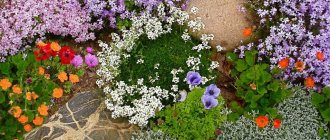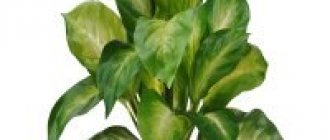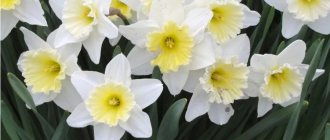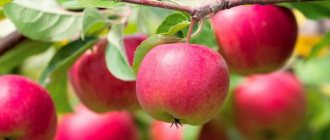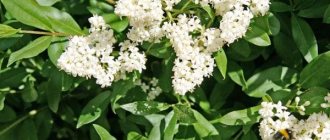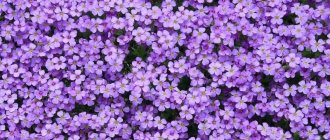Pros and cons of short conifers
When people talk about low conifers for summer cottages, they mean plants whose size is too small and uncharacteristic for this species. But such a definition cannot be called accurate, because if a tree in the wild reaches 20 m, and some of its varieties are only 10 m, they will not be considered dwarf because of this. Conifers are called small if in adulthood their height does not exceed human height and their width does not exceed the span of an arm.
Gardeners are attracted to the dwarf form of conifers with a number of advantages:
- they are an exact copy of tall trees, including all their stages of development;
- do not take up much space, which allows you to place several coniferous trees and shrubs in a relatively small area;
- compositions made from dwarf plants do not lose their decorative appearance all year round;
- ideal for planting in rockeries;
- tolerate winter well;
- they can be kept in containers and created various New Year's compositions.
Despite the obvious advantages of mini conifers, they also have some disadvantages:
- poor resistance to fungal diseases, which requires careful removal of dried parts of the plant and treatment with fungicides;
- the shape of the crown suffers, because in the spring there is a risk of branches breaking off;
- many dwarf varieties have a short lifespan;
- difficult to propagate by cuttings;
- there is a risk of damage to the needles from the bright spring sun.
But gardeners do not refuse small conifers for their summer cottages, because they are very decorative. And with proper care, these plants will not cause problems.
General rules for placing conifers in the garden
Landscape designers, when creating compositions from coniferous trees, adhere to the following rules:
- A composition of trees and shrubs will be holistic and harmonious only if the distance from the place of the most convenient view is no less than two times the length of the composition itself.
- The most preferable background for coniferous plants is a well-groomed lawn.
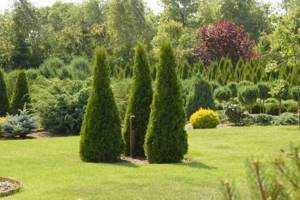
- Coniferous shrubs and trees look beautiful near ponds in the company of weeping deciduous plants.
- An effective solution is to place conifers in landscape design with their orientation to the east or west.
- It is not advisable to plant coniferous plants next to roses, since evergreens tend to oxidize the soil, which is bad for sensitive roses.
Conifers are indispensable when creating a gravel garden.
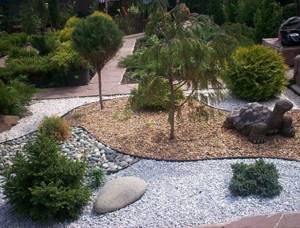
Coniferous plants of different types have a wide range of colors. When combining plants into a single design element, it is important to consider a number of rules for color combinations:
- A composition of three elements should contain no more than 2 colors.
- A composition of five elements will look impressive if it contains no more than 3 different shades.
- Compositions consisting of 25 or more copies must be divided into groups of 3 elements, in which rule No. 1 must be observed.
When arranging conifers, it is important to take into account the growth of plants and the state of the crown in adulthood, so that the harmony of the composition is not disturbed over time.
Dwarf conifers in landscape design
In modern gardening, dwarf coniferous trees are experiencing the peak of their popularity. They are a decoration for any garden plot. There are connoisseurs who collect entire collections of dwarf fir, spruce, pine and other representatives of the species.
The most successful people in growing small coniferous trees are in Holland. They offer a conditional classification of conifers:
- full-grown - growth is up to 30 cm per year, at the age of 10 years such coniferous crops reach a height of 3 m;
- medium-sized (semi-dwarf) - their size ranges from 15 to 30 cm;
- dwarf - no higher than 15 cm;
- mini-dwarf - up to 10 cm;
- microdwarf - no more than 5 cm.
Small conifers are used almost everywhere: single or group plantings, flower beds, containers. They are often located at the entrance to the house. Dwarf coniferous plants for the garden will attract attention in any type of landscape.
Advice! When purchasing small forms of trees, you need to carefully study the name - the form nana, dwarf or prostrata should be written on the label.
Experienced gardeners can determine at first glance how much a dwarf tree can grow, which allows them to correctly place it on the site.
Tips for buying dwarf conifers
- When choosing a dwarf plant, make sure that it is really a dwarf: the Latin name on the label should indicate the form 'Nana' or dwarf (dwarf), 'Prostrata' (prostrate), but most cultivars have individual names, and it is simply necessary to write them down before purchasing !
- With the experienced eye of a gardener, one can determine exactly how many centimeters the plant will grow upward or sideways each year.
But this is not the end of our story about dwarf conifers, because... the main dwarfs that are more often found on sale are cultivars of junipers, thujas, and we will talk about them further.
Lyudmila Uleyskaya, Yalta, 7dach.ru
Types and varieties of low-growing conifers for a summer cottage
There are many varieties of each type of low-growing conifer, which allows you to choose the one suitable for a particular landscape. They are all decorative and differ in sizes and shades of needles. Such small plants will fit even on a small plot of land. Below are the names and photos of the main low-growing conifers in the garden.
Pines
Dwarf representatives of pine trees have a spreading crown and needles collected in small bunches. The number of needles in bunches differs for each variety. The needles are replaced every few years. Pine trees are the most unpretentious conifers. It is important to ensure proper placement and care in the first year of life. Such plants love light and tolerate frost and drought well.
Small forms of mountain pine are popular among gardeners: the Gnom variety with long needles and a spherical crown, grows up to 1 m; varieties Mops and Ophir reach only 0.5 m in height.
Variety Gnom in the photo:

Ate
Very often, dwarf versions of spruce trees are used in gardens and parks, as well as in summer cottages. The most common:
- The low-growing form of common spruce of the Little Gem variety has a flat-rounded crown, annually gives an increase in height of about 2-3 cm and reaches 0.5 m by the age of 10 years.
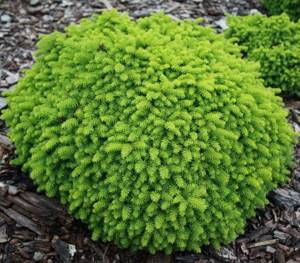
- The miniature format of Canadian spruce is represented by Laurin varieties with a crown in the form of a narrow cone, spherical Echiniformis and Alberta Globe, which looks like a hemisphere. They add up to 2 cm per year, and at the age of ten their height is only 0.4 m. Laurin spruce in the photo:

- A variety of prickly spruce is the nest-shaped dwarf spruce variety Nidiformis.
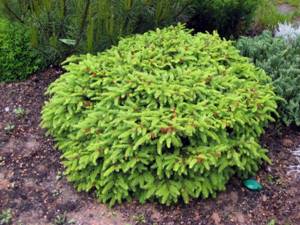
So named because of its crown shape with a slightly flattened top. Every year it gains 3-4 cm in height, but mostly in width. The height of this conifer rarely exceeds 1 m. - The Maxwellii variety is the smallest representative of the prickly spruce, reaching only 0.6 m. Thanks to these parameters, the conifer is often grown in containers as a New Year tree.
Junipers
Junipers are represented by many dwarf forms. The most popular of them:
- Wiltonii - grows only up to 10 cm and gains height very slowly. Recommended for planting in large groups or individually, but among large stones.
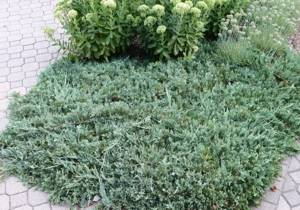
- Green Carpet - plant height is around 10-15 cm, but the juniper spreads to the sides by 1.5 m. The needles are non-thorny, undemanding to watering, and withstands severe frosts well.
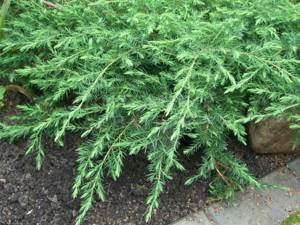
- Repanda is a dwarf creeping juniper, 30 cm high and about 1 m wide. It has soft needles and a flat crown. Also used for green roofs, it can withstand harsh conditions.
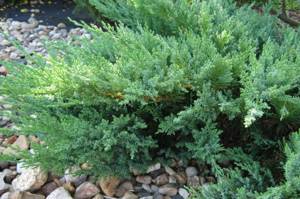
- Spotty Spreader is a creeping dwarf conifer up to 20 cm tall, growing 2 m wide. In the sun, the ends of the shoots become creamy.

- Pfitzeriana Compacta - bushes grow up to 30 cm and spread 2 m around. It grows quickly, the needles are soft, there are no hard shoots, which makes it look like a soft grass lawn.

larches
Dwarf larches are represented by such varieties as Larix decidua, Compacta, Kornik, Marta Radek. The latter is the most popular; it has a spherical crown and is grown in standard form, reaching 1 m in height.
The Marta Radek variety is shown in the photo:
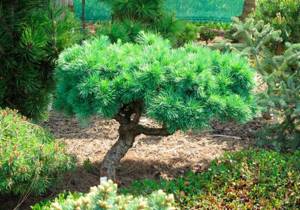
Tui
Cypress conifers are mostly heat-loving, but there are also cold-resistant varieties. Most dwarf trees are very miniature, however, shrubs are also found in this group. In any case, their size allows you to plant low-growing varieties in the plots; they look very impressive. There are two types of cypress conifers:
- with yellow needles, they are placed in well-lit places;
- with green needles, suitable for growing in light shade.
Most often, gardeners can find dwarf thuja. The Amber Glow variety is interesting for its golden hue of needles and its small size - its height is only 1 m. Oriental thuja has a low-growing Aurea Nana variety. These small conifers have a dense oval crown with many branches and a sharp crown. The needles are golden-green in color during warm periods and bronze during cold weather. Western thuja is represented by several dwarf varieties - Caespitosa, Danica and Hoseri.
Amber Glow variety with a golden hue:
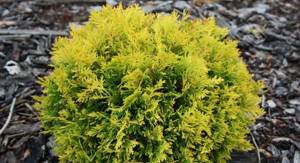
Fir
Fir is a fast-growing conifer. They are usually placed in partial shade, in areas protected from the winds. The soil must be moist and good drainage must be ensured. Caring for small fir trees is simple and includes loosening the soil and timely sanitary pruning.
Attention! For the winter, it makes sense to cover these conifers with spruce branches only in the first year of life.
The most famous dwarf varieties are balsam fir Nana and Korean Tundra.
Fir Nana:

Type of low-growing conifer - Tundra fir:
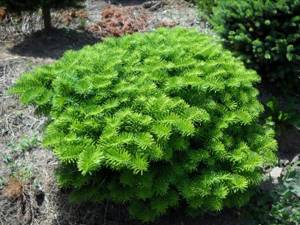
Hemlock
The Canadian hemlock has a small form, which does not exceed 1 m in height when mature. The shoots grow to the sides, spreading out quite strongly, and their tips point down. The needles of the dwarf conifer are about 2 cm in size, green and shiny. The plant loves moist soil and tolerates being in the shade and severe frosts.
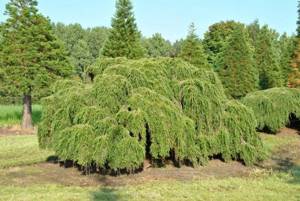
Advantages of dwarf coniferous forms
- They exactly copy their original, only in miniature, which allows you to get to know their lives better and observe all the stages of their development.
- Due to their compactness, they take up little space.
- With their help, you can create static compositions that are decorative throughout the year.
- Very harmonious in rockeries.
- They are valued for their ability to be used in containers as a New Year's tree or New Year's compositions.
- They overwinter well, covered with snow “almost up to their heads.”
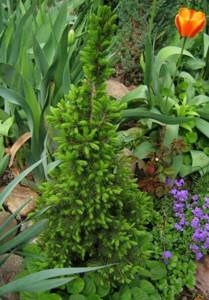
Features of growing low-growing varieties of conifers
Small forms of conifers have growing rules that are common to all species. Planting is carried out at the end of April or beginning of May, depending on climatic conditions. Usually, dwarf forms of seedlings are purchased in specialized stores, and care must be taken to ensure that the quality of the material is high. The main thing is to check the integrity of the earthen coma; it must be at least ⅓ of the entire seedling, otherwise the plant may not take root. It is worth paying attention to the rich color of the conifer needles and their elasticity; these indicators indicate the good quality of the seedling.
Advice! The best temporary packaging for the root system of dwarf conifers is burlap.
Landing is carried out in this way:
- the hole should be slightly larger than a clod of earth;
- a mound is poured in the center, reaching ⅔ of the height of the pit;
- a conifer seedling is placed on the top of the embankment, and the roots are carefully spread along its slopes;
- then the plant is buried, simultaneously compacting the soil;
- the seedling is well watered;
- dry soil should be poured around the trunk;
- The final stage of planting is mulching the soil with peat.
Caring for dwarf conifers involves watering, sanitary and, if necessary, decorative pruning. In winter, it is worth removing excess snow so that it does not break thin branches and trunk.
Basically, dwarf conifers are susceptible to the following diseases:
- Brown schutte is a very common disease; it is a fungus that mainly affects young specimens. The needles become brown and covered with a gray-black coating. It is treated with preparations containing copper and fungicides.
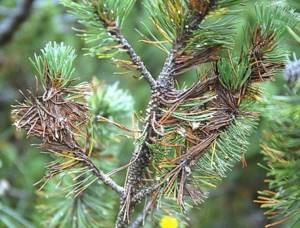
- Rust - fungus causes orange spots to appear, which then turn into brown growths. Slow down the growth and development of the tree. Drugs such as Fitosporin-M and Abiga-Pik are used.

- Gray mold or rot - gray mycelium appears on the needles. Fungicides are effective against it.

- Fusarium - a fungus that causes the plant to dry out. The needles begin to turn yellow, become rough to the touch and fall off. The whole plant gradually dries out. It is almost impossible to cure a tree; Fundazol is used for prevention.

Pests of small forms of conifers include:
- Bark beetle - lives under the bark, making many moves there. They live mainly in forest plantations and can spread from there to a summer cottage. The insect selects weak trees that die as a result of such an invasion. They fight the pest with the help of special preparations.
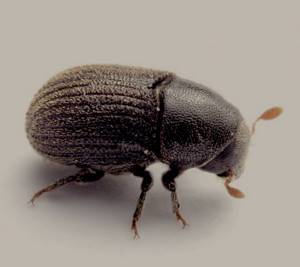
- Sawfly - under this name many insects are united, attacking mainly spruce and pine. Pests eat shoots that dry out and break. They get rid of them using special preparations or an ash solution.
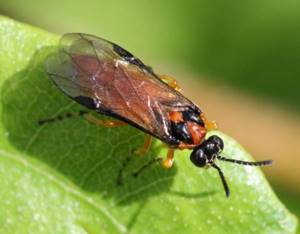
- Hermes are parasitic insects that drink plant sap. Seals form on the tree, branches are also deformed, and buds are destroyed. The method of control is insecticides.

- Scale insects - attack dwarf thujas, yews and junipers. The needles turn brown, then turn yellow and fly off. The tree becomes weaker and dies. Insecticidal preparations are effective against scale insects. Onion peel is suitable as a folk remedy.

Canadian spruce
All types of Canadian spruce have the ability to blend harmoniously into gardens of a variety of styles. This is facilitated by their regular and strong crowns.
Daisy White
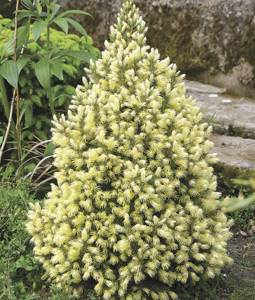
An elegant, uniquely beautiful coniferous tree with a cone-shaped crown. Young growths are creamy white, then turn green. Variegated coloring appears in well-lit areas. An ideal conifer for owners of small plots.
Konika
Cone-shaped spruce with a thick, dense crown, characterized by slow annual growth. It grows two to three meters high.
Echiniformis

Small spherical spruce. It grows very slowly and until the age of ten grows in diameter to only 30-50 centimeters.
Rainbow End
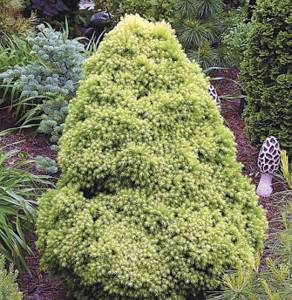
Dwarf cone-shaped spruce. Despite the two-time summer growth, at the age of ten it grows up to one meter in height. Valued for its decorative needles - summer young shoots are yellowish in color.
Sanders Blue

A small tree, up to one meter high. It is distinguished by a silvery-bluish tint of needles.
Landing rules
The planting scheme for coniferous crops depends on their size, but not only. If these are single plantings in which the plant should reveal itself in all its glory, then between large specimens leave 1 to 3 meters. And between dwarfs there is about 50 cm.
If the goal is to create a hedge, then the distances between neighboring plants are chosen taking into account their density and crown diameter.
Advice. Tall conifers take root better in a new place at a young age, but for dwarf varieties it does not matter - they can be planted as adults.
Landing dates
To make it easier for plants to survive transplantation, you need to choose the optimal timing for it. They largely depend on the condition of the root system of the seedlings.
- If it is closed, i.e. If the plant is replanted with a large earthen ball at the roots, it can be planted at any time from mid-September to the end of March. Even in winter, excluding frosty days.
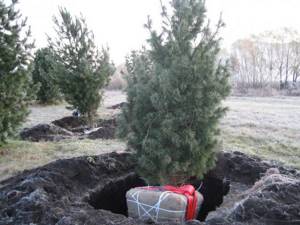
With a closed root system, even large trees can be replanted
- For seedlings with an open root system, the best time for planting will be September-October and April.
Preparing the site
If planting is planned in late autumn or winter, then you need to mark the places and dig holes in advance. In this case, the top fertile layer of soil is mixed with peat and sand, bone meal is added, mixed and stored in a warm place.
When preparing planting holes, follow these rules:
- Their size in plan should be larger than the earthen lump, and the depth should be such that at least 3-4 cm remains from the lump to the surface, and a fertile soil mixture can be poured under it in a layer of 7-8 cm.

The parameters of the planting pit are selected in accordance with the size of the root system
- The walls of the pit must be vertical.
- Its bottom must be loosened and the roots of perennial weeds removed.
- If the soil is sandy, clay is placed at the bottom instead of a fertile mixture.
Landing
Seedlings of coniferous plants are usually sold with a lump of earth - in containers, nets or with a closed root system wrapped in burlap. You need to try not to destroy it during transportation and carrying.
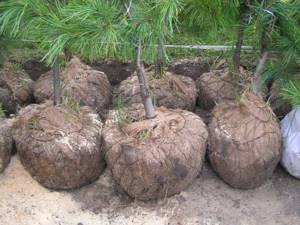
Seedlings in a net
When planting, the plant is lowered into the prepared hole as is, and only in it is the protection cut and removed in order to maintain the density of the earthen clod.
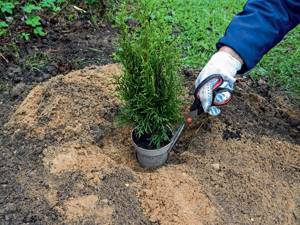
To avoid exposing the roots, do not open the container ahead of time.
Before planting, the plant is well watered, the empty space between the walls and the earthen ball is filled with prepared soil mixture and compacted. Then fill the hole with soil from above to a thickness of 2.5-3 cm and compact it to create a depression for irrigation.
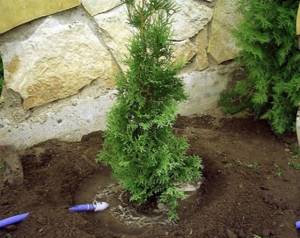
Watering after planting
If the plant is young and tall, it can be swayed by the wind, depriving it of its vertical position. To prevent this, the stem is wrapped in a piece of soft rubber or burlap and tied to a support.
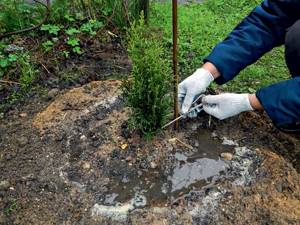
Tying to a support
Advice. Tall trees are secured by bracing: they are tied to three supports located along the perimeter, pulling the ropes.
Wintering of conifers
Most conifers growing in open ground do not need shelter for the winter. It may only be required for miniature container crops decorating terraces, balconies and summer cottages.
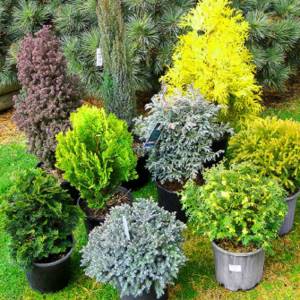
Container crops may not survive the winter
The root system is especially vulnerable. Therefore, for the winter, such plants are transplanted into the ground with or without a container, and the soil around them is mulched with a thick layer of peat, sawdust, compost or crushed bark.
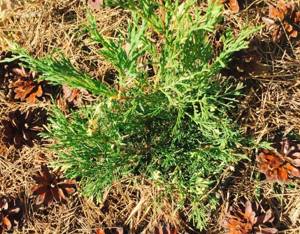
Ideal mulch - pine needles
Balcony plants, if they cannot be transplanted into the ground, are insulated differently: place the pot in a large container and fill the space between the walls with crumpled paper, foam plastic, peat or any other heat-retaining material. Then the container is placed on a piece of thick foam, and the soil in the pot is mulched or covered with a layer of snow.
The needles of plants overwintering in sun-exposed areas must be protected from burns. They most often occur at the end of winter and beginning of spring, when frosts are still severe, but the sun is already shining brightly.
To do this, large plants are covered with non-woven material, and over small ones you can build a hut from branches.
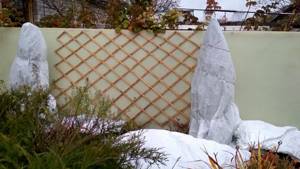
This wrapping will also protect the branches from breaking under the weight of snow.
